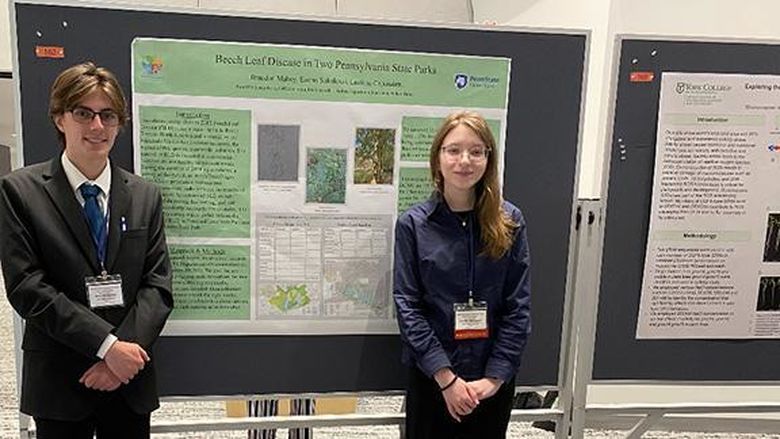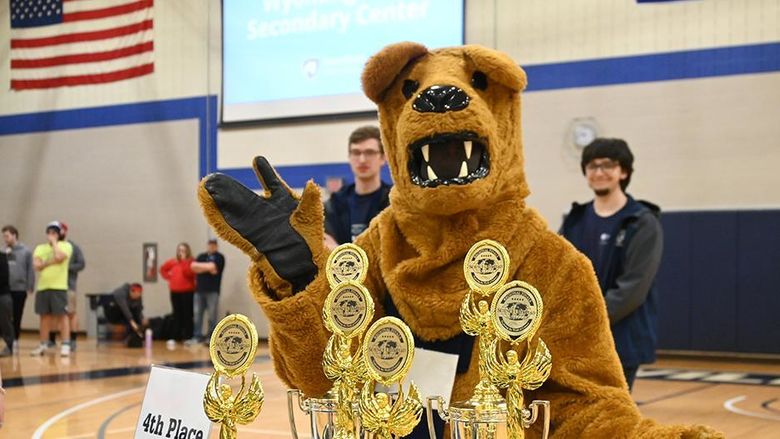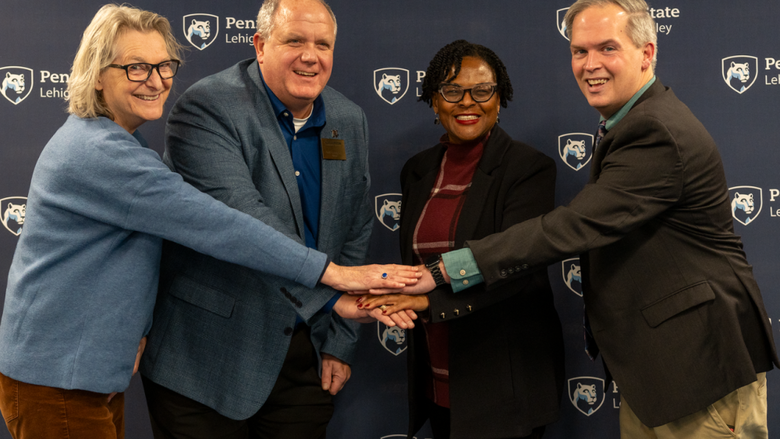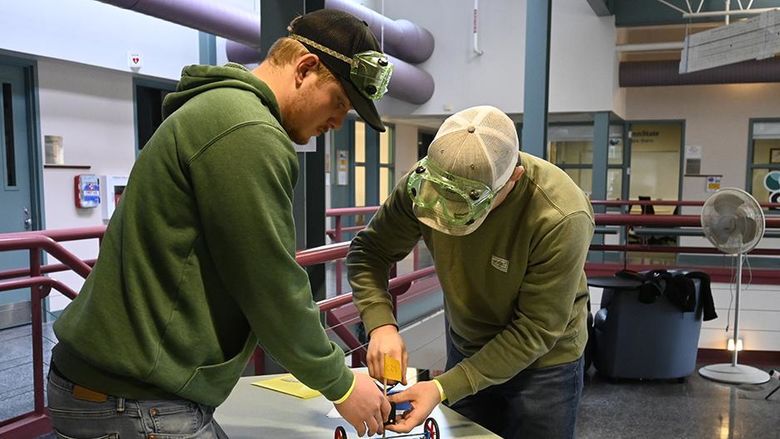
Those at the training were, from left: Rebecca Sarver, assistant teaching professor of criminal justice; Kevin Chichura, juvenile probation officer, Wyoming County; Daralynn Carr, deputy director, Wyoming County; Krystle Kowalczyk, director of probation services, Wyoming and Sullivan counties; Morgan Theobold, juvenile probation officer, Wyoming County; Tammy Goodwin, victim/witness coordinator, Wyoming County; John Shorter, juvenile probation officer, Sullivan County; and Jeremy Olson, assistant professor of criminal justice.
DALLAS, Pa. — Two faculty members from Penn State Wilkes-Barre conducted restorative justice training with members of the Wyoming and Sullivan County Juvenile Probation Departments, sharing the concepts of restorative justice and how it can benefit them in their work.
Rebecca Sarver, assistant teaching professor of criminal justice and program coordinator for the Penn State Wilkes-Barre criminal justice program, and Jeremy Olson, assistant professor of criminal justice, developed the training and presented it to members of the departments in December. The restorative conferencing training was the first phase of working with the counties. The second phase includes case management using a program developed by Sarver and Olson that includes their research on happiness along with restorative justice.
“We offered our assistance in working with victims of crime, and they were very open to it,” Sarver said. “They are looking to institute more restorative justice practices and were interested in learning more about how to do that. We suggested doing some conferences between the person who did the harm and the person who was harmed. The goal was to give them the skills so they can start doing restorative conferencing.”
Restorative justice is a philosophy that focuses on growth and recovery, serving justice while rebuilding relationships. Restorative practices are designed for all parties involved to heal properly and strengthen their future relationships. Restorative conferences bring the victim together with the person who did the harm, along with a support person for each party and a facilitator such as a probation officer. Both the person harmed and the person responsible have a chance to ask scripted questions such as “What impact has this incident had on you and others? What has been the hardest thing for you? What do you think needs to happen to make things right?” and “What were you thinking at the time? What have you thought about since? Is there anything you would like to ask or say to the person harmed?”
“Victims tend to be the forgotten people in crime scenarios. The focus becomes not about helping them heal, but keeping the community safe from offenders,” Sarver said. “The person who did the harm never really has to say they’re sorry but just has to serve their time, whether it be prison or probation. With restorative justice, that is a necessary component. But the involvement of both parties is completely voluntary.”
She explained that prior to a conference occurring, preparation must occur so both parties know what to expect and what they want to express to the other. This allows officials to determine if and when the parties are able to come together for a conference.
“It can be very helpful for a victim to meet with the offender to get closure,” Sarver said. “One of the biggest things the victims want to know is ‘Why did this happen?’ This is an opportunity for the offender to say, ‘This is what was going on in my life at the time this happened’ or ‘This is why I did this crime.’ The point of the conference is to allow the victim to really have a voice in saying how this incident harms them, going well beyond victim impact statements. In order to have a conference, the person who did the harm has to be prepared to issue an apology, but in no way does the person who was harmed have to accept that apology.”
Sarver and Olson developed the training specifically to meet the needs of the local counties. Two students, Steven Qarmout and Isabella Salvaggio, assisted in creating a video of an example of a restorative conference between the person who did the harm and the person who was harmed. The training also included components for participants to complete before the in-person sessions began.
“There is a component of restorative justice in all the courses we teach and the program is very focused on that concept. Steven had already worked on some happiness research with us and gotten a better understanding of restorative justice,” Sarver said. “Both students had to learn about restorative conferencing through reading and discussion and were able to serve as the actors for our video recordings. They got to develop a sense of how it would feel to go through something like this.”
The training was held at the Wyoming County Courthouse over two full days. During the first day, Sarver and Olson presented the basic concepts of restorative justice and discussed the purpose of restorative conferencing. On the second day, they showed the videos of restorative conference examples that they created with the students prior to having the attendees complete practice exercises to mimic what a real-life restorative conference would look like.
Those attending the training were the deputy director and a probation officer from the Sullivan County Juvenile Probation Department, the director and three probation officers from the Wyoming County Juvenile Probation Department and an individual who works with victims for both counties.
“The training not only taught us what restorative justice is, but with the interactive participation, it also helped put the reason for restorative justice into perspective,” said Heather Finnegan, deputy director, Sullivan County Probation. “Dr. Olson and Dr. Sarver are both extremely knowledgeable in the program that they teach, bringing practical, educational, and personal experiences to share. Their method of teaching is stellar. Our department is looking forward to implementing this program within our juvenile justice program to restore the harm done to victims and create balance within the juvenile justice system.”
Sarver said the officers who played the role of the victims were using real scenarios.
“It really helped them see how victims could heal from going through restorative conferencing. At the end of the training, some of the officers told us they could see how the conferences would work for the types of cases they get,” she said.
Krystle Kowalczyk, director of probation services and treatment court coordinator, Wyoming and Sullivan counties, said, “This training consisted of logical concepts, attainable goals and tangible outcomes and was one of the most rewarding trainings I have attended in the field of juvenile justice, evidence-based practice and restorative justice. This program appears to be a very productive initiative to repair the harm for victims and rehabilitate criminal justice involved youth. We look forward to implementing what we have learned to achieve our goal of being restorative and balanced in our approach to juvenile justice.”





